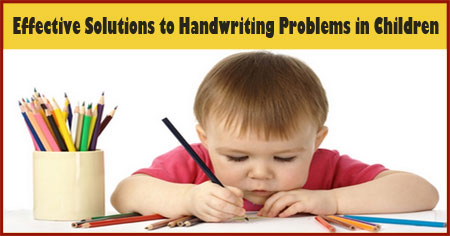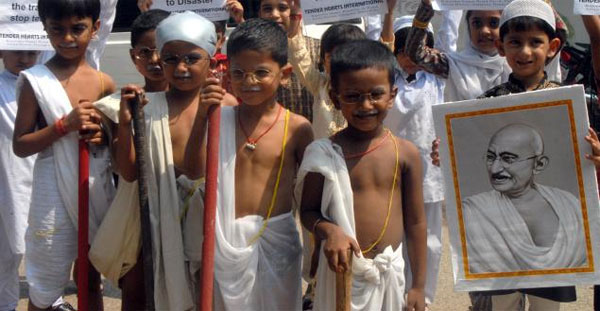Getting rid of handwriting problems and helping children to improve handwriting is a must to help them excel in their academics. Read to find effective solutions to handwriting problems in children.Handwriting is something that matters a lot. A person’s handwriting is sometimes his or her identity. Students are often judged in exams by their handwriting. The first thing people tend to observe is your handwriting. It is essential that parents take care to improve their child’s handwriting from a young age.Children very often have handwriting problems. This can be taxing to them in future. Here are some solutions that can help you solve your child’s handwriting problem. In this articleGripSizeConcentrationLegibilityBooksPlacementClear ConfusionGripThe first step towards good handwriting is to grip or hold the pencil properly. Many children have wrong grips which make their handwritings bad. Gripping the pencil wrong makes your child’s writing slow and in a bid to finish on time your child’s handwriting turns into illegible scrawls.You should try to improve your child’s grip. Make your child pinch things like tongs or cloth clips. Making your child join dots or colour will improve their grip. Children tend to copy adults so show your child how exactly you grip the pencil and encourage them to do the like. Make them practice writing fast at home so they do not face trouble in school.SizeThe size of your child’s letters is an index of their handwriting. Children obviously start by writing big letters but over time your child must learn to write small. Small handwriting is clearer and neater, and useful in the long run. You should yourself write in a smaller font in front of your child, so that they copy you. The alphabets of your child might become bigger in size when they try to write fast, but they must practice to write smaller fonts even when they have to write fast.ConcentrationThe reason for your child’s bad handwriting might be that they are not concentrating on what they are writing. Teach your child to first think about what they are going to write, and then carefully write out the sentences with minimum spelling errors. They should concentrate on what and how they are writing. If they pay attention to writing and make a conscious effort to write properly their handwriting is bound to improve.LegibilityOne basic problem with children is that their alphabets are not clear and legible. One cannot distinguish between a ‘d’ and a ‘b’. Make them read and write the alphabets many times till their alphabets are perfect. Then make them write words and see if their alphabets are legible when combined into words. Then make them practice running handwriting and make sure that their alphabets are legible here too.BooksGive them handwriting practice books and make them write out sentences and words again and again. The more they practice writing the more their writing will improve. Make them practice as many times as possible and keep checking that their handwriting is legible and neat and straight. Do not encourage your kids to write in a curvy, bendy way as such handwriting later becomes illegible.PlacementChildren tend to write their letters outside the assigned lines of the notebook. This can later cause a problem, as your child’s handwriting might turn into what is called ‘floating handwriting’. The letters start to get all jumbled up with the letters in the lines above and below it. They should practice writing within the lines and their letters should not go below or above the lines. Teach them how to fit in the tall letters like l, k, t and hanging letters like p, g, and q.Clear ConfusionMany children are often unable to distinguish between ‘d’ and ‘b’ , ‘p’ and ‘q’ and so on. To avoid such confusion you must teach your child to assign some signs to these letters. For example, if your child is right-handed you must teach your child that the curve of ‘b’ is towards the hand with which your child holds the pencil. With such signs you can help your child to avoid getting confused between small letters.All these will surely contribute to your child having a good handwriting that is legible, neat and will give people a good impression about him or her. Be patient with your child, improving handwriting takes time.What kinds of handwriting problems are common in children? What are the causes of handwriting problems in children? How to help children get rid of handwriting problems? Discuss here.
 Getting rid of handwriting problems and helping children to improve handwriting is a must to help them excel in their academics. Read to find effective solutions to handwriting problems in children.
Getting rid of handwriting problems and helping children to improve handwriting is a must to help them excel in their academics. Read to find effective solutions to handwriting problems in children.Handwriting is something that matters a lot. A person’s handwriting is sometimes his or her identity. Students are often judged in exams by their
handwriting. The first thing people tend to observe is your handwriting. It is essential that parents take care to improve their child’s handwriting from a young age.
Children very often have handwriting problems. This can be taxing to them in future. Here are some solutions that can help you solve your
child’s handwriting problem.
Grip
The first step towards good handwriting is to grip or hold the pencil properly. Many children have wrong grips which make their handwritings bad. Gripping the pencil wrong makes your
child’s writing slow and in a bid to finish on time your child’s handwriting turns into illegible scrawls.
You should try to improve your child’s grip. Make your child pinch things like tongs or cloth clips. Making your child join dots or colour will improve their grip. Children tend to copy adults so show your child how exactly you grip the pencil and encourage them to do the like. Make them practice writing fast at home so they do not face trouble in school.
Size
The size of your child’s letters is an index of their handwriting. Children obviously start by writing big letters but over time your child must learn to write small. Small handwriting is clearer and neater, and useful in the long run. You should yourself write in a smaller font in front of your child, so that they copy you. The alphabets of your child might become bigger in size when they try to write fast, but they must practice to write smaller fonts even when they have to write fast.
Concentration
The reason for your child’s bad handwriting might be that they are not concentrating on what they are writing. Teach your child to first think about what they are going to write, and then carefully write out the sentences with minimum spelling errors. They should
concentrate on what and how they are writing. If they pay attention to writing and make a conscious effort to write properly their handwriting is bound to improve.
Legibility
One basic problem with children is that their alphabets are not clear and legible. One cannot distinguish between a ‘d’ and a ‘b’. Make them read and write the alphabets many times till their alphabets are perfect. Then make them write words and see if their alphabets are legible when combined into words. Then make them practice running handwriting and make sure that their alphabets are legible here too.
Books
Give them handwriting practice books and make them write out sentences and words again and again. The more they practice writing the more their writing will improve. Make them practice as many times as possible and keep checking that their handwriting is legible and neat and straight. Do not encourage your kids to write in a curvy, bendy way as such handwriting later becomes illegible.
Placement
Children tend to write their letters outside the assigned lines of the notebook. This can later cause a problem, as your child’s handwriting might turn into what is called ‘floating handwriting’. The letters start to get all jumbled up with the letters in the lines above and below it. They should practice writing within the lines and their letters should not go below or above the lines. Teach them how to fit in the tall letters like l, k, t and hanging letters like p, g, and q.
Clear Confusion
Many children are often unable to distinguish between ‘d’ and ‘b’ , ‘p’ and ‘q’ and so on. To avoid such confusion you must teach your child to assign some signs to these letters. For example, if your child is right-handed you must teach your child that the curve of ‘b’ is towards the hand with which your child holds the pencil. With such signs you can help your child to avoid getting confused between small letters.
All these will surely contribute to your child having a good handwriting that is legible, neat and will give people a good impression about him or her. Be patient with your child, improving handwriting takes time.
What kinds of handwriting problems are common in children? What are the causes of handwriting problems in children? How to help children get rid of handwriting problems? Discuss here. 











 Getting rid of handwriting problems and helping children to improve handwriting is a must to help them excel in their academics. Read to find effective solutions to handwriting problems in children.Handwriting is something that matters a lot. A person’s handwriting is sometimes his or her identity. Students are often judged in exams by their
Getting rid of handwriting problems and helping children to improve handwriting is a must to help them excel in their academics. Read to find effective solutions to handwriting problems in children.Handwriting is something that matters a lot. A person’s handwriting is sometimes his or her identity. Students are often judged in exams by their 

















